
When Were Power Windows Invented?
The power window is the unsung hero of the modern world. It’s a device most of us rely on daily, and when it’s not there, it can ruin your whole day. Power windows are, as most of us know, windows that are opened and closed by pressing a button. This is a vast improvement over hand-cranked car windows, but they weren’t always common.
When were power windows invented?
Power windows came on the scene in the 1940s when they were added as a luxury feature in the 1940 Packard 180 series. Although the name of the actual engineer who invented them is lost in the mists of time, we do know that Packard was the first company to use them in an automobile. The invention came about because of power-assist technology that was developed before World War II. It was a hydro-electric system that was used to raise and lower vehicle tops. This was the inspiration for the first power window.
In the late ’40s, General Motors incorporated a hydro-electric system as a package in its convertibles, controlling the windows, convertible top, and front seats. Ford got into the act and added the system to its high-end convertibles during the same time period.
Cadillac embraced the technology for its 75 Series limousines. They were the first to have a power window to raise and lower between the driver and the rear passenger compartment. By the end of the ’70s, power windows were standard in many vehicles.
At first, power windows had rocker or toggle switches to make them move, however, this proved to be a safety hazard for children because they can put their head out of the window and accidentally lean on the switches. In response to petitions, the National Highway Traffic Safety Administration banned rocker and toggle switches on power windows. Since 2006, U.S. auto manufacturers must equip cars with lever switches.
How do power windows work?
While early power windows used a hydro-electric system, today’s power windows work quite a bit differently. Now, and electric motor controls the process, connected to several different gears. It is similar to how a hand-cranked window works, except a motor provides the power instead of you.
Wires fed through the driver’s door allow the driver to control all four windows from one controller. Automatic up/down function and controlling the windows with a remote from outside are now features that most drivers take for granted.
Other car window innovations

Entire industries have been built up around car windows. Child safety windows, when the glass in the rear passenger doors will only roll down part of the way, were invented to keep children from falling out the windows of moving vehicles. This mechanism is now found on the rear passenger windows of most vehicles.
Auto glass itself has also seen amazing innovations from the days when windshields were optional on vehicles. Modern auto window glass is very high-tech and protects occupants and interiors with tints and UV filters. Shatterproof glass is also now common, with side windows made of tempered glass that disintegrates into hundreds of little pieces instead of breaking into dangerous shards. In addition, it is only a matter of time before side windows become as smart as modern windshields that are loaded with sensors to help drivers avoid accidents.
Next time you put your finger on that handy little button to open the window and let in the breeze, think of how far the humble car window has come. Luckily, we’re now out of the dark ages and no longer have to hand-crank our car windows.


